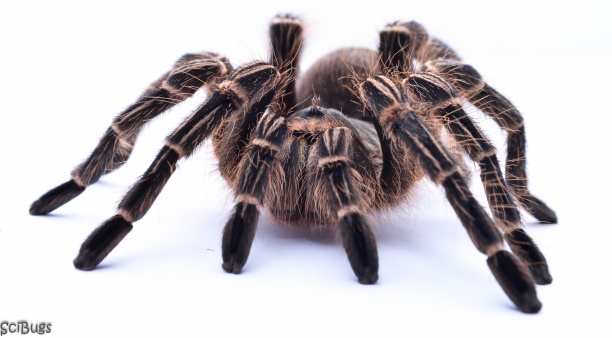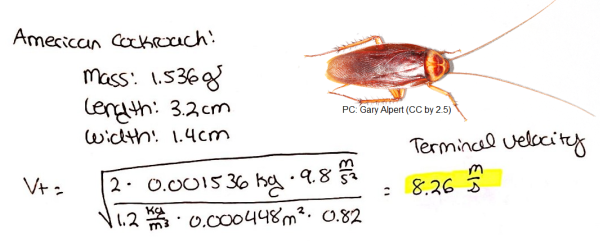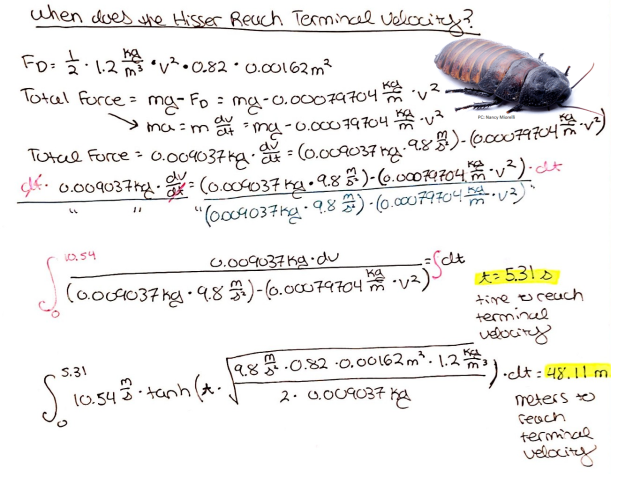Written by Nancy Miorelli Math Help from Matt Zawodniak
https://twitter.com/zpravycz/status/591537087985291264
If you’d like a snarky answer, then this is going to be short and you can go on your merry way. The bug would probably just fly away. Even insects with wings that aren’t meant for long distances would be able to slow themselves down enough to minimize injury.
In fact, lots of bugs are flying as high in the sky as when you are told you can use your “approved electronic devices” on airplanes (about 10,000ft).
But, I’m guessing that’s not really the purpose of this question. First, let’s start with “buggy things” that don’t have wings.
Any sort of arachnid will take falling damage. Even a fall from just a few feet is enough to severely damage, and in some cases kill, a full grown tarantula. This is because they’re prone to hemorrhaging (or internal bleeding) between their joints. For the most part, tarantulas and other large arachnids are ground dwellers. They’re not built to fall out of things.
So in this case, they’ll definitely go “splat” and probably won’t survive.
Okay, but what about cockroaches?
Here’s where it gets complicated. I ran theoretical physics calculations and empirical testing for the sake of fully answering this question. So if you’re in for a ride, keep reading.
The question at hand is basically a terminal velocity question. At what point will a cockroach in free fall reach terminal velocity, or the fastest the cockroach could fall due to gravity’s pull, and how much damage will that speed do when it smacks into the ground.
Methods
Physics Calculations

Empire State Building
381 m (1,250 ft)
PC: David Shankbone (CC by SA 3.0)
To solve this, I took two approaches. One was to calculate terminal velocity of a cockroach. Then, to ensure the cockroach would reach this speed, I calculated the time it would take to reach terminal velocity, and from that the distance the cockroach would fall before reaching terminal velocity. I used the Empire State Building as my model “Tall Building” since we already make problems about dropping pennies off of it.
I crunched these numbers for a German Cockroach, an American Cockroach, and a Madagascar Hissing Cockroach. I used dimensions and weight that I obtained from real organisms in order to do the second part of this question for the terminal velocity equations.
Variables
Projected area for the cockroach was assumed to be a rectangle since we assumed it would probably fall flat and flutter around instead of nose diving. We used the Drag Coefficient for a long cylinder since it looked the most “rectangley” compared to the others, and the cockroach is basically a cylinder. Again, we’re assuming the roach is falling flat. Air density was averaged between the top of the Empire State Building and the bottom. The acceleration due to gravity was approximated to be 9.8 m/s².

1) Calculate terminal velocity.
2) Calculate at what time the roach reaches terminal velocity using drag force.
3) Use time to determine meters at which the roach reaches terminal velocity.
Calculations
Physics is hard. There’s a reason I didn’t take it after high school. Fortunately, I have a fiance who’s getting a PhD in theoretical math, so I had some help … lots of help.
The first thing we did was to calculate the terminal velocity of the three cockroaches, using the dimensions of some of our own specimens. More details on that later. We found the terminal velocities to be 5.54 m/s (12.07 mph) for the German Cockroach, 8.26 m/s (18.48 mph) for the American, and 10.54 m/s (23.58 mph) for the Hisser.
This is the fastest the cockroach could possibly go, and thus create the most damage upon its not so soft landing.
Then, we had to determine if the cockroach would reach terminal velocity by time it hit the ground after being dropped from the Empire State Building. Therefore, we calculated the time at which it would take for each of the cockroaches to reach terminal velocity and then at what distance down the empire state building that would be.

In 3.52 second after falling 24.25 m (75.96 ft) the American Cockroach will reach terminal velocity.
Empirical Testing
Admittedly, the numbers we got seemed, to me, to be a little quick.
As my Dad says, “One experimental result is worth 1,00o expert opinions.”
So off to my back stairwell we went, to determine if our theoretical calculations seemed plausible and determine “splat factor.”
The empirical method was dropping dead cockroaches from the top of my 3rd floor apartment back stairwell (about 7.62m [25ft]). The German and American cockroaches were obtained from a UGA lab and euthanized before the experiment., while dead hissers were obtained from both the UGA insect zoo and one of the UGA labs. Matt, my fiance, was kind enough to stand at the bottom of the stairs with a stopwatch and time how long it took for each of them to hit the ground. I used three cockroaches for each species and dropped them twice from the stairwell. The cockroaches I used for for the dimensions in my previously mentioned calculations were ones that had the most consistent fall times between trials. There was no wind upon conducting the experiment.

I dropped three cockroaches for each species and dropped each cockroach two times. However, I only formally recorded one from each subset which had the most consistent fall times. I then used these times to check our theoretical calculations.
In all three cases we found that the results of our theoretical calculations seemed plausible as the cockroaches rapidly approached their terminal velocities in as little as 7.62 m (25 ft).
Splat Factor
None of the German Cockroaches, out of the three dropped, splatted when they hit the ground. They have enough air resistance so they don’t fall with very much force.
Two of the three American Cockroaches had some issues. All three of the Hissing Cockroaches also did not fare the trial very well. However, one of them only had problems on the second drop. All the cockroaches that sustained damage didn’t completely splat. It also seemed that of the cockroaches that were damaged, most of them were pregnant females.
Cockroaches are heavily armored on the front of their body. They have a strong pronotum, which is the shield looking part that cover their head. However, the rest of their body isn’t heavily sclerotized and is particularly prone to damage between segments. So if the cockroach landed on its thorax, it would most likely be okay.
They didn’t “splat” so much as the fat body and eggs were forced through one of the connecting segments (I hope you’re not eating anything). Would this be enough to kill the cockroach?

These cockroaches were dead prior to the initiation of the experiment.
The female American Cockroach (right) sustained falling damage.
No. Insects don’t have blood vessels like you and I do. All their fat and internal organs just kind of hang out in a blood bath contained by the exoskeleton. That’s why when you step on bugs they kind of pop like a balloon. Because of this, insects have to have mechanisms to protect themselves if they were to lose a leg or something. They have scabbing mechanisms to prevent bleeding out.
The cockroach would definitely be damaged, but nothing more than a cockroach could handle. We don’t have sayings about them for nothing. If you can survive a nuclear war, you can survive a fall from the Empire State Building.
Cockroaches can live 7 days with their head cut off and only stop then because they die of starvation and dehydration after that time. Cockroaches can even survive nuclear explosions. So, after falling, the cockroach would probably be subject to predation in its injured state, but would be fine in the fact it could still walk around and get food.
These calculations won’t generalize to all insects. Beetles, for example, are very heavily armore., They have a really thick, strong exoskeleton and therefore could handle a fall. Many beetles live in tree tops and would have to survive a fall to the forest floor.

This is an Ironclad beetle. Its exoskeleton is so strong that collectors have to drill through their exoskeleton to put a pin through them.
You can step on them, and it doesn’t even hurt them. They’d be fine falling from a tree or a tall building.
PC: Steveprutz (CC by SA 3.0)
Too Much Math; Didn’t Read
Our empirical testing supported our theoretical calculations. None of the German Cockroaches sustained damage. Two of the three American Cockroaches and all three of the Hissing Cockroaches ruptured between a segment in their abdomen, but did not “splat” in a way that would outright kill them.
We were testing dead insects. Many cockroaches and other insects spread their legs out when falling to increase air resistance and slow their fall, kind of like skydivers do.

Dat air resistance tho
PC: Douglas S. Smith (Public Domain)
Furthermore, tall buildings, like the empire state building, have strong updrafts up the sides. Even big, heavy insects are light enough to be caught in the updrafts. So your bug wouldn’t even land near the base of the building. The updrafts make them tumble around in the air and carry them farther away from the building.
In short, most likely the insect would be a little hurt, but would quite literally – walk it off.
Insects with relatively harder exoskeletons, like beetles, would probably fair the fall better.
Arachnids like large tarantulas or scorpions would easily be damaged and would probably die, as even a fall from a few feet is enough to severely damage an arachnid.
This is, of course, assuming that your bug are wingless, as otherwise they just fly away.
Extra:
Here’s the MythBusters on them firing a penny at it’s terminal velocity to see if it’ll break bones or embed in concrete.











Pingback: Links 7/17/15 | Mike the Mad Biologist
I enjoyed the article a lot! Thanks
LikeLike